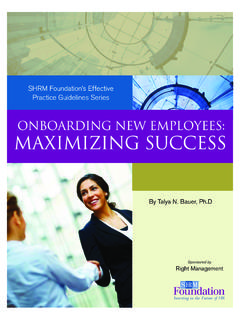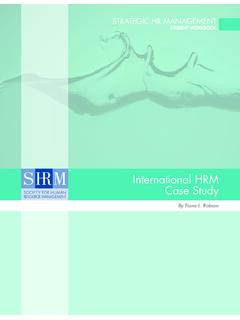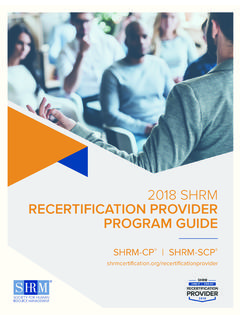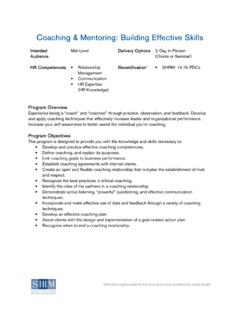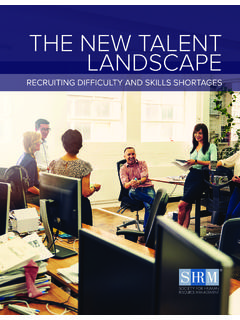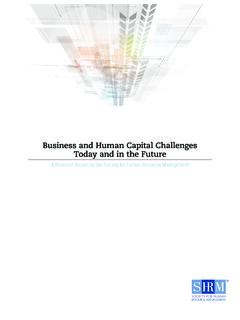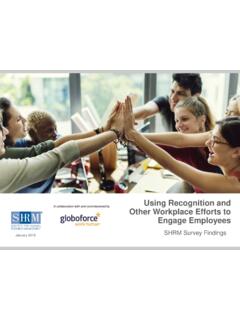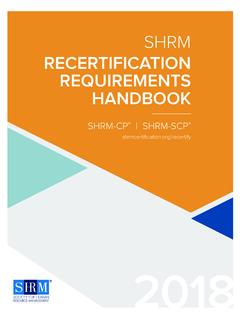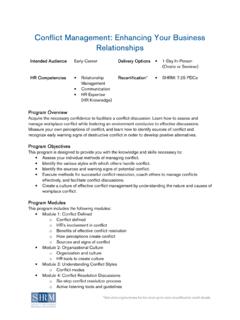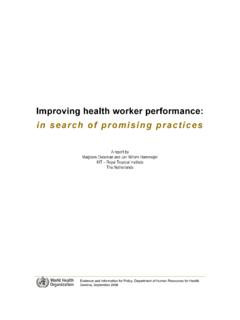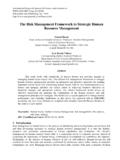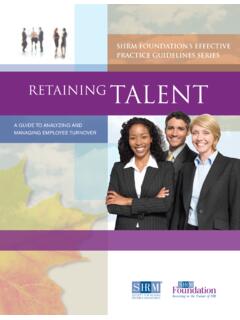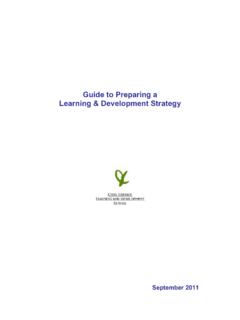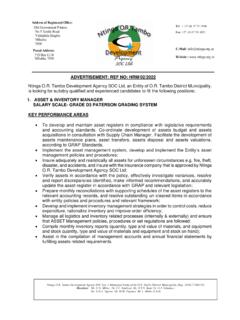Transcription of Human Resource Management Policies and Practices in the ...
1 Human Resource Management Policies and Practices in the United States CRANET 2014/15 Summary Report September 9, 2015 Dr. Elaine Farndale Dr. Maja Vidovic Elizabeth Rockey E-mail: in collaboration with the Society for Human Resource Management (SHRM) Center for International HR Studies (CIHRS) School of Labor and Employment Relations The Pennsylvania State University 2 ABOUT THIS REPORT About CRANET The Cranfield Network on International Human Resource Management (CRANET) was launched in 1989 to collect information regarding Human Resource Management (HRM) Practices and Policies worldwide. Today, more than 40 academic partners across the globe collaborate to collect this data, making it the largest on-going HRM study in the world.
2 The project s aim is to gain insight into best Practices in the HRM field, to compare patterns of HRM Policies and Practices across countries, and to explore how HRM changes over time. Findings provide updated information about HRM Practices for practitioners and academics, as well as policy makers and international institutions, for use with research or policy change. For more information about CRANET, you can visit About CIHRS The Center for International Human Resource Studies (CIHRS) is the US partner of CRANET. CIHRS is an initiative of the School of Labor and Employment Relations at the Pennsylvania State University (USA), which aims to encourage IHRM scholarly research, and to serve the International HR practitioner community.
3 Through targeted events, our goal is to develop a strong community of academics and practitioners passionate about international HRM, enabling the sharing of ideas to advance knowledge and practice in the field. More details about CIHRS can be found on the web site: About SHRM Founded in 1948, the Society for Human Resource Management (SHRM) is the world s largest HR membership organization devoted to Human Resource Management . Representing more than 275,000 members in over 160 countries, the Society is the leading provider of resources to serve the needs of HR professionals and advance the professional practice of Human Resource Management . SHRM has more than 575 affiliated chapters within the United States and subsidiary offices in China, India and United Arab Emirates.
4 Visit SHRM Online at About the Data The 2014/15 data (693 responses) in this report were collected by members of the Center for International Human Resource Studies (CIHRS) at the Pennsylvania State University and in collaboration with the Society for Human Resource Management (SHRM). The 2004 (260 responses) and 2009 (1,052 responses) data were collected by members of the ILR School at Cornell University (previous CRANET partner). Where possible, the 2014/15 data are compared with 2004 and 2009 data to show trends over time. Due to some changes in the questionnaire, trend data are not available for all items presented in the report; in these cases, only 2014/15 data are presented. Acknowledgements The authors of this report would like to thank the faculty of the School of Labor and Employment Relations at the Pennsylvania State University for their input in discussing these CRANET study findings.
5 We would also like to thank SHRM Research for their support in compiling this report. This is the final report published from the CRANET/SHRM/CIHRS 2014/15 data collection exercise. 3 EXECUTIVE SUMMARY The 2014/15 CRANET/SHRM/CIHRS data are a clear reflection of how organizations across the are recovering from the recent global financial crisis. The research results show that many firms are reporting strong financial returns and optimism for the future. Despite this financial prosperity, organizations do not appear to be spending these gains on employees: labor costs have declined slightly, along with the number of employee benefits being offered. Where possible, this report compares the 2014/15 findings with those from 2009 and 2004, revealing emerging trends over the last decade.
6 Some of the findings and trends are summarized below: The HR function is increasing its strategic role. Relying predominantly on recruiting the head of HR internally from the organization s HR department, HR leaders are more often part of the Board or equivalent top executive team. Human Resource Management (HRM) strategies are also being formalized in writing. Clear distinctions are emerging between the HR function and line Management in the responsibilities for HRM policy decisions, combined with high reliance on technology-based systems. [Pages 6-8] Organizations are increasing the size of their workforce and are also reporting higher levels of employee turnover than in recent years.
7 Where downsizing has been necessary, it has been achieved primarily through recruitment freezes, wage freezes and voluntary attrition. The recruitment that does take place is predominantly through in-house activities, such as internal hires and postings on company websites, with emphasis on attracting minority groups. The use of commercial job websites is also increasing. In contrast, other selection methods, including application forms, references and one-on-one interviews, among others, are being used less frequently than in the past, according to research findings. The use of part-time work is decreasing, while teleworking and shift-work are on the rise. [Pages 9-14] Appraisal processes frequently require the input of employees themselves, often leading to recommendations for future training and career development needs, as well as pay decisions.
8 Organizations are becoming smarter with providing training, as the average number of training days is increasing, likely due to greater use of e-learning systems and on-the-job training. [Pages 15-16] Perhaps related to stock market volatility, the use of incentives based on stock options and profit sharing as a part of Management compensation has decreased. Similarly, the practice of offering employee benefits that exceed statutory requirements has been declining slightly, except for health care insurance (likely related to recent changes in legislation). [Page 17] The concentration of trade union members and the percentage of organizations recognizing trade unions have increased slightly. Nevertheless, perceptions of trade union influence in organizations remain low.
9 Downward communication is most commonly taking place through electronic means, whereas upward communication is done through supervisors. Both upward and downward communication rely little on collective representation. [Pages 18-20] The 2014/15 CRANET/SHRM/CIHRS data are a clear reflection of how organizations across the are recovering from the recent global financial crisis. 4 5 TABLE OF CONTENTS 1. INTRODUCTION 7 2. HRM ACTIVITY IN THE ORGANIZATION 8 HR Department 8 Technology and Outsourcing 9 3. STAFFING Practices 11 Downsizing 11 Recruitment and Selection 13 Diversity and Inclusion Programs 15 Working Arrangements 15 4. EMPLOYEE DEVELOPMENT 17 Employee Appraisal 17 Training 18 5. COMPENSATION AND BENEFITS 20 6.
10 EMPLOYEE RELATIONS AND COMMUNICATION 22 Trade Unions 22 Communication Methods 23 7. STUDY METHODOLOGY 25 Sample Demographics 26 6 7 1. Introduction Organizations that participated in the 2014/15 survey, which was administered from October 2014 to May 2015, included a similar percentage of private-sector firms as previous administrations of the survey (42%), with similar median organization size (750 employees). The predominant employee type remains clerical/manual. More information on the demographics of responding organizations can be found in section 7, Study Methodology. The 2014/15 CRANET/SHRM/CIHRS data can be seen as an indicator of how organizations have been recovering from the global financial crisis.
